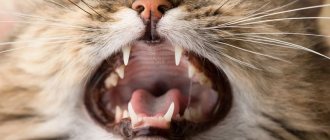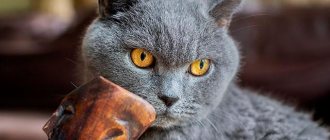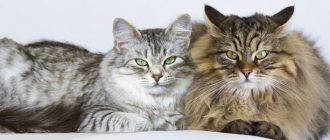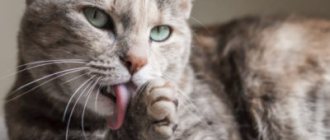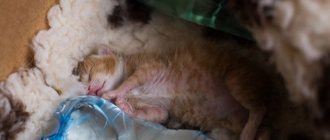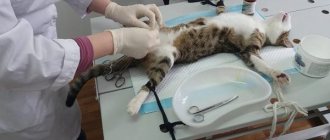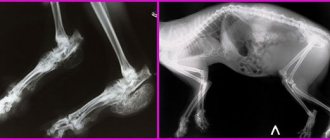From childhood I remember this belief that if a dog or cat has a lot of black spots on its palate, then its character is necessarily evil and aggressive. But is this true or just baseless rumors? Maybe someone knows for sure?
Yes, I heard about this too. But you know, I have a German Shepherd with a black sky. Just a great cable. Kind and affectionate and not at all evil. True to us. True, towards strangers and strangers he is rather angry, but it seems to me that this is the case with all dogs. I haven’t met cats with black skies, or maybe I just didn’t pay attention. Therefore, I can’t say anything about this.
Yeah, yeah, I heard this too, and firmly believed it) ) ) , but over the course of life experience I had to double-check this belief, it’s complete nonsense! The character of a cat and dog does not at all depend on the colored parts of the mucous membrane or the color of the skin and fur. This is if we stopped and thought a little. Which person is more evil, the one who is dark-haired or the one who is blond? I think the comparison is appropriate) How powerful these rumors and beliefs are. How much time does it take for us to begin to refute, check, compare, think about it? One day a woman began to tell me about the dangers of cotton swabs; it says on the packaging that they should not be put in the ear. I asked her why, in her opinion, this is? She answered me that she has no idea, but since it is written like that, it means it’s harmful, maybe some kind of cotton wool is not right or the stick is made of harmful wood. And the fact that this stick was simply wooden and could simply break off in the ear did not even occur to her. But, forgive me, this is from another opera, probably.) )
As far as I know, this belief applies to German shepherds and it seems that in puppies the palate determines whether they will be angry. In practice, I don't think this is true. I also had a shepherd with a black palate, but he was the kindest and most affectionate dog. And now there is a Dalmatian, whose entire mouth is also covered in black spots, but to say that she is evil is even funny. Perhaps, of course, upbringing also played a role here; I don’t need an angry dog. But then this belief is just a myth. Because dogs with black palates must be naturally evil.
This is an old prejudice that has nothing to do with reality. This is how only grandmothers in villages choose dogs, who heard this from their grandmothers and have no idea about genetics and heredity. Security qualities depend only on genetics. If the parents were guarding, then the puppy will be.
A black palate is a sign of good pigmentation. The better the pigmentation, the better the immunity. Therefore, in any case, when you choose a puppy (no matter for what - to guard the house or play with children), you should always give preference to puppies with black lips and palates than those with pink or spotted ones. The same goes for the rim of the eyes: it should be black, the nose should also be black. After all, even at dog shows, they often reduce the score of those who, for example, have spotted lips, pink eye rims or a pink spot on the nose. But this is not connected with anger, but with the general strength of the immune system.
they say yes. but we always kept a lot of dogs, and the black sky was by no means an indicator. the lapdog with the pink mouth was ready to tear anyone apart, and the Caucasian with the black sky was the kindest dog
This is bullshit. The character of a dog does not depend on the amount of pigment. For example, black Labradors and Newfoundlands are the kindest dogs. Although they themselves and their mouths couldn’t be blacker.
I heard about this, but didn’t pay attention, oddly enough, dogs with a black sky tried to dominate due to their youth, which indicates a good character, one was with a light sky so neither fish nor fowl.
This is known about cats and dogs. If a cat or puppy has a black palate, then it is evil. this is true. I had a cat with a black palate - he just attacked everyone. others did not behave this way. The dog with the black palate is very angry. Although I’m not a dog handler, there is such a sign and so far it’s justified.
We are constantly adding new functionality to the main interface of the project. Unfortunately, older browsers are not able to work well with modern ones.
Source
online now
We are VKontakte
Lentigo
The most common cause of black spots in a cat's mouth is increased pigment formation. Sometimes kittens are born with small spots, which become more noticeable as they grow older. These dark marks are called lentigines and their appearance is not dangerous for furry pets. However, stains with this defect should not:
- itch;
- protrude above the surface of the skin and mucous membranes;
- have a rough surface;
- peel off.
Most often, lentigo occurs in red or tortoiseshell cats.
Oncological diseases
An alarm bell for the owner of a mustachioed tabby is the appearance of black spots in the mouth of older cats. These may be signs of melanoma, a malignant neoplasm that affects the skin and mucous membranes. In more severe cases, dark spots are metastases spreading to the oral cavity from organs affected by the tumor.
Associated symptoms. The owner needs to take the cat to the vet if, in addition to spots in the mouth, it:
- feels anxious;
- becomes apathetic;
- loses appetite;
- looks exhausted.
Oncology is rare in cats, but if the malignant origin of the spot is diagnosed, surgical treatment is prescribed.
Blackheads can often be seen not only inside, but also around the oral cavity, in places where the sebaceous glands are most concentrated. This is acne or so-called blackheads. Sometimes their appearance is a hereditary factor, but most often they arise due to:
- the animal's sloppiness;
- deficiency of vitamins and minerals in the body;
- stressful situations;
- allergies due to incorrectly selected care products;
- feeding from a person's table.
Acne usually does not require treatment and disappears immediately after eliminating the negative factors.
Traditional methods for eliminating acne. Traditional medicine advises:
- Wipe the surface with black spots daily with celandine infusion.
- Apply lotions with yarrow decoction to the affected areas.
- Take a cut of a pumpkin and wipe it over acne areas. This procedure should be carried out several times a day with a fresh cut.
- Treat blackheads with a decoction of calendula and chamomile.
Of the official medications, you can use a weak solution of Furacilin or Clotrimazole. After this, apply sulfur ointment to the spots.
Papillomavirus
In kittens under six months of age, dark spots are often found on the tongue and inside of the cheeks, similar to voluminous birthmarks with a flat top. They are called oral papillomas or warts. Such stains should be removed as they can rub and cause pain when fed.
Since these warts can easily be confused with a cancerous tumor, diagnosis and treatment are carried out only under the supervision of a veterinarian. Most often, a course of antiviral drugs, such as interferon, is prescribed. You can also give your pet a special vaccine, with which it will develop lasting immunity to the papilloma virus for a long time. More expensive but effective ways to treat warts are cryotherapy and laser therapy.
Mechanical damage to the oral cavity
Curious and overly active pets love to play with different objects and try them out. Quite often this leads to disruption of the integrity of the mucous membrane of the palate, cheeks or tongue. If the damage is not noticed in time, infectious agents can enter the wound and it begins to fester.
During infection, the mucous membranes of the mouth become covered with a black coating. The mouth begins to smell rotten. Sometimes such symptoms indicate that the cat has problems with teeth and gums.
Fungal infections are one of the causes of blackness in the corners of a pet’s mouth.
Having noticed something black near the mouth of a cat, pet owners should be wary - such a sign may indicate the development of fungal diseases. It is not possible to determine the type of infection on your own; special studies will be required.
The danger of the disease is that if left untreated, the disease will progress rapidly. The lesion spreads through the mucous membranes and affects internal organs. Fungal spores can also penetrate the mucous membranes of the eyes and ear canals.
Avitaminosis
Black spots on the tongue can occur due to a lack of vitamin B2.
This is caused by an unbalanced diet or consumption of economy-class feed. If your cat has dark spots in its mouth, sleeps a lot, eats poorly and loses a lot of fur, you can introduce the following into its diet:
- sprouted grains of buckwheat, corn and peas;
- wheat germ;
- unboiled cow's milk;
- egg white;
- dandelion leaves;
- dry brewer's yeast.
When feeding commercial food, it may be necessary to additionally introduce complex supplements of B vitamins, but this can only be done with the permission of a veterinarian.
Many people believe that only aggressive cats have black spots in their mouths. But observations of them prove that the character of the animal does not depend on the dark coating. Spots can appear even in calm, affectionate animals, and only the attentiveness of the owner will help to detect dangerous diseases in time.
Sometimes owners notice that the cat has black spots in its mouth and begin to worry. In fact, this phenomenon occurs quite often. It is inherent not only in cats, but also in dogs. In most cases, we are talking about natural processes that do not pose a threat to the health and life of the animal. Only occasionally are dark spots in or around the mouth caused by some kind of pathology. This article discusses the most common reasons.
Folk signs about dogs
Do you believe in folk signs that have been tested for centuries? For example, I believe. It is interesting to read and compare signs related to the weather, birth, weddings, holidays and so on. There are many observations related to animals. But I was especially interested in folk superstitions about dogs.
But it turned out that folk signs about dogs alone take up several pages. And there are also beliefs, legends, superstitions, which are no less interesting to read than a blockbuster. I tried to choose the most interesting.
*Is your dog missing? Call her name up to three times through the chimney, when the first smoke comes out of the newly flooded stove, the dog will be found.
Regarding the last objection, I had a lot of objections. Well, I don’t agree and that’s all. By the way, here are the words of Metropolitan Kirill of Smolensk and Kaliningrad on this topic:
“I treat animals well and love dogs very much. I have three dogs in Moscow and two in Smolensk. The Church has never considered dogs unclean animals and has never forbidden them to enter premises. Many people are against allowing a dog to enter a church, but not for theological reasons, but for reasons of a purely traditional, historical nature, rooted, as it seems to me, in ideas about hygiene.
[. ] I want to say that the ban on dogs entering the temple is not recorded in canon law. This is simply part of the tradition, and the same tradition probably extends to horses, piglets, chickens, geese and other animals. We must love animals, because by showing love to animals, we train our human emotions and become more humane.”
Interesting selection. I heard about many signs, some amused me, for example, calling a dog through a chimney, with some
Source
Lentingo
Behind the “scary” word “lentingo” lies an absolutely harmless phenomenon that explains why a cat has black spots in the mouth (on the gums or palate) and near it (on the nose, on the lips, on the chin). This skin defect is a common pigmentation that is also characteristic of humans.
Lentingo is the most common cause of dark spots in the mouth. In the vast majority of cases this is exactly what happens. Kittens usually have clean, uniform oral tissues. Later, small spots a few millimeters in size may appear.
Over time they grow and sometimes reach a couple of centimeters. Their number often increases. You can notice lentingo already at the end of the first year of a cat’s life, if she is prone to its appearance. At a later age, spots rarely appear.
Most often, lentingo in or near the mouth is noticed in ginger cats. This can be compared to freckles, characteristic of people with sunny hair color and fair skin. Also in the “risk” group are tortoiseshell cats. Lentingo spots:
- smooth;
- do not protrude above the surface of neighboring tissues;
- do not peel:
- don't itch;
- don't hurt;
- do not cause any other discomfort to the animal.
If everything is exactly as described, there is no reason to worry. Although it wouldn’t hurt to show the cat to the doctor just in case.
If your cat has black spots near the mouth rather than inside it and they look more like dots, it may be acne. They love to “settle” on the chin, where the sebaceous glands are most active. However, they can appear in other places. The most common causes of acne are:
- Unbalanced nutrition, when the diet lacks the vitamins and minerals the cat needs. This often happens if the animal is fed from a common table.
- The sloppiness of a cat that walks around with food residue on its chin.
- Poor environmental conditions.
- Severe stress experienced by the animal.
- Dirty dishes.
- An allergic reaction to a detergent or other irritant.
- Hereditary factor.
All other causes, except the last one, can be eliminated, and the black spots around the mouth will disappear. If it’s a matter of genetics, you will have to come to terms with and console yourself with the thought that the spots do not cause any harm to the cat’s health.
Oncological diseases
If you look into a cat’s mouth, you can see black dots on the gums that weren’t there before, and the animal is already many years old, you can sound the alarm. Such spots may be a manifestation of melanoma, a dangerous cancer associated with pigmentation.
The tumor is sometimes located on the oral mucosa or metastasizes here, being located in another part of the body. The second option is sadder than the first, because it speaks of an advanced stage of the disease and the futility of treatment.
Melanoma in cats does not only appear as dark spots. The animal loses its appetite, looks exhausted, and apathetic. As soon as the first alarming signs appear, the pet needs to be shown to a veterinarian. In the case of oncological tumors, it is extremely important to start treatment in a timely manner.
However, cancer is not common in furries. In most cases, spots on a cat's lips or mouth turn out to be normal pigmentation. The doctor will examine the animal and, if necessary, prescribe a diagnosis and explain why the color of the mucous membrane has changed. After this you will be able to sleep peacefully.
Cat owners are concerned about black spots that appear in the mouth, lips or chin. Why do they arise? What is their danger?
In what cases should you accept a cosmetic defect? When can you cope with the disease on your own? What symptoms indicate that you need to seek veterinary help? This article answers the questions raised.
- Causes
- Why do black spots appear in my cat's mouth?
- Mycoplasmosis
- Acne
- Viral papillomatosis
- Fungal infections
- Lentigo
- Conclusion
ZooForum: Is this true? — ZooForum
Remember that by reacting to advertisements published here, you risk running into scammers who want to profit from the misfortune of others and the kindness of citizens.
The forum administration cannot verify the authenticity of ALL funds and their details. And it cannot prohibit the publication of such advertisements.
The attached topics contain announcements from those who collaborate with the forum administration and whose existence we have no doubt about.
Is it true? Character Definition
I don’t know about explanations, my statistics are as follows: over the last 10 years, 3 cats and 3 cats with pink palates are good-natured, 1 cat and 1 cat with black palates are evil
I heard about this too, and I’m sure it’s true. I had a cat with a dark upper lip - a miracle, not a cat. Lips are probably not as important as the sky
Oh, don’t tell me, I have two cats with a pink palate, they are so capricious, one can bite, the second is a total beast, and the last one with a black palate is a pure Siberian felt boot, a teddy bear. I heard something else: the cat’s horoscope very accurately reflects the character of the furry cat, and the characters of the parents. My Siberian felt boot just gave birth to kittens, and bugs also have different personalities. The funny thing is that there are two of them, one is a copy of my dad in appearance, but my mother’s character, and the second is a copy of my girl, but with my dad’s character. And our daddy is a famous Siberian, a fighter and a Chechen, he will bite to death and not choke. So one at a time.
There are breeds that must have a black mouth, and a pink one is considered a defect. Now she has climbed into the mouths of her dogs, the Newfah’s mouth is black, even her tongue has black spots, and the St. Bernard’s too. But both are the kindest creatures!
Exactly! We have a pink mouth and we are good! Only now we wake up very early, around 5 am, but I still want to sleep! And then he will eat, come to scratch my head and purr affectionately
Source
Why do black spots appear in my cat's mouth?
Symptoms, diagnosis, treatment, control measures and prevention of diseases or pathological conditions are not the same, therefore a separate subsection is devoted to each of them.
Mycoplasmosis
Mycoplasmas are creatures intermediate between viruses and bacteria that do not have a formed cell membrane. Most animals are carriers of mycoplasma, but individuals with weakened immune systems become ill.
The reasons are unbalanced nutrition, as well as chronic non-contagious or infectious diseases. Dark spots appear on the lips, tongue and around the mouth.
In addition to the main pathological symptoms, additional ones develop:
- conjunctivitis;
- purulent nasal discharge;
- loss of appetite;
- miscarriages.
If the above symptoms are detected, seek veterinary help. The doctor prescribes immunomodulators and antibiotics.
Prevention consists of maintaining immunity at the proper level when the following conditions are met:
- complete feeding with professional food or feed mixtures prepared by cat owners who have the skills to prepare a diet;
- quarterly deworming and regular disinsection;
- vaccination: special biological products against mycoplasmosis have not been developed, however, by following the vaccination plan, general immunity is formed.
Blackheads (comedones) appear around the lips and on the chin, that is, in places with sparse hair and an abundance of sebaceous glands. The epidermis tends to constantly renew itself. However, the surface of the acne becomes keratinized and the exfoliated dead scales do not fall off, but stick to the renewed surface. The accumulated biological debris is contaminated with secondary microflora, which actively multiplies. An inflammatory process develops.
In some cats, the pathological condition goes away on its own and does not cause concern. Others scratch the affected areas, secondary flora joins, and the inflammatory process spreads throughout the body. Veterinarians divide the causes of acne into external and internal.
External ones include contamination of the chin with the remains of fatty food contaminating the walls of a plastic bowl. Even if the feeder is glass or ceramic, if it is rarely washed, a coating of saliva and food debris will form. The cleanliness of the water bowl should not be neglected. It is necessary to change it twice a day, rinse it regularly and wash it whenever it gets dirty.
Among the internal reasons are the following:
- stressful situations;
- hormonal surges;
- hereditary predisposition;
- feed allergy;
- treating yourself to table scraps.
Treatment consists of sanitizing the inflamed areas with anti-inflammatory wound healing agents. The hair is trimmed and a thin layer of ointments prescribed by the veterinarian is applied.
Recovery occurs after 2-3 weeks. If the desired effect is absent, the veterinarian adjusts the treatment.
Prevention consists of replacing plastic feeders with glass or ceramic ones. After each feeding, wipe the cat's chin with a napkin soaked in an antiseptic. Bowls are washed daily.
If an inadequate reaction to food components occurs, professional hypoallergenic food is used. Do not add food if the cat has not finished the previous portion. They do not treat you to table scraps.
Viral papillomatosis
Warts occur in kittens up to six months old or older pets over seven. These are benign tumors that arise under the influence of a virus that constantly circulates in the animal’s body. The causative agent of the disease multiplies in animals with an imperfect or weakened immune system.
When papillomas form in the mouth cavity - on the gums, cheeks or tongue, they interfere with the process of chewing and swallowing food. Drooling develops, the cat loses appetite or refuses to eat. The coat becomes dull, disheveled, and the breath smells unpleasant.
Warts can appear in the corners of the mouth, around the eyes, and on the paws. If the strength of the immune system is restored when unfavorable factors are eliminated, papillomas disappear without any treatment. In some cases, injections of immunomodulators help.
If conservative treatment does not help, resort to electrocoagulation, cauterization with a laser or liquid nitrogen. Self-removal of a tumor by mechanical means is unacceptable, since it contributes to the degeneration of a benign tumor into a malignant one.
To prevent the disease, take the same measures as for the prevention of mycoplasmosis.
Fungal infections
The disease is manifested by the appearance of black spots in the corners of the mouth. The disease occurs as a result of side effects of medications used to treat bacterial infections.
Therapy consists of the use of antimycotics prescribed by a veterinarian. Ignoring the problem leads to systemic diseases of internal organs and threatens the life of the pet.
Lentigo
The congenital anomaly occurs in cats of red or cream color. Black spots appear on the gums, lips, and spread to the face.
The first spots resemble freckles and appear in one-year-old animals. The cosmetic defect does not cause discomfort in the cat and cannot be treated.
Why is the sky dark at night?
If the Universe is made up of billions of galaxies, each populated by billions of stars that have been emitting photons for billions of years, then why isn't it flooded with light? German astronomer Wilhelm Olbers (1758-1840) pondered this in the 1820s, and the mystery became known as Olbers' paradox, or photometric paradox. Even ancient astronomers and philosophers wondered why the sky was dark, and wondered whether behind this darkness lay the secret of the evolution of the Universe. These learned men were true visionaries!
In fact, there is more light in the universal darkness than we think. Even in deep space, far from the stars of the Milky Way, intergalactic space is not completely black. It glows due to the so-called diffuse extragalactic background radiation (EBR). This radiation consists of photons emitted by all the stars and galaxies that have ever existed, and is represented by light of all wavelengths, from ultraviolet to infrared. The light from distant galaxies is very weak because intergalactic space is huge and at this scale there are not many galaxies that are luminous (or that once were). As the Universe expands, the photons emitted by galaxies throughout its history have scattered throughout space and gradually become rarer. In addition, as a result of expansion, light from distant galaxies underwent a red shift—its wavelength increased, moving into a region of the electromagnetic spectrum invisible to the eye.
It is impossible to directly observe extragalactic background radiation due to the high brightness of modern stars and galaxies. But in 2012-2013. A group of astrophysicists (including two of us, Alberto Dominguez and Joel Primack) were able to "see" extragalactic background radiation based on data obtained by the Cosmic Gamma-ray
Source
Main causes of spotting
Black spots in a cat's mouth occur due to the influence of various factors that determine the type of disease.
Acne looks like dark rashes or small pinkish pimples. They are located outside - around the mouth area, on the lower lip.
The favorite place to appear is the chin, as the sebaceous glands actively work there.
Causes:
- Incorrect feeding. For example, giving food from the table. This leads to an imbalance of nutrients, a lack of vitamins, microelements and other useful elements.
- Pet uncleanliness. Often cats do not remove the remaining food from their faces, which provokes inflammation of the skin.
- The influence of stress factors.
- Response to irritation by an allergen. It appears as a rash in areas of interaction with the irritant.
- Negligent attitude of the owners towards the cleanliness of the bowls.
- Genetic disease.
The first 5 reasons can be eliminated, then the animal will return to normal. With the hereditary transmission of dark rashes, you will have to come to terms with the fact that they will not go away. They will also not cause harm to the cat's health.
Symptoms: dark acne; inflammatory reaction on the mucous membrane of the lower lip; suppuration and swelling of rashes; the appearance of crusts in the oral cavity. Acne occurs from time to time, but more often it is chronic.
Lentigo
The most likely cause of dark spots in a cat's mouth. In this case, the stains are harmless. They are characteristic not only of animals, but also of humans. Lentigo appears in adult animals in the form of small pigmented areas. Whereas in kittens, the oral cavity is the same shade, clean. With age, the size and number of spots increase.
Localization of skin defects - gums, palate, nose, lips, chin. Type of spots: on the same level with the mucous membrane or skin, smooth surface, no itching, peeling, pain, or discomfort.
Red and spotted cats are susceptible to lentigo. You can compare them to freckles in humans.
Fungus
Fungal diseases are rare. The cause is the development of fungi with a decrease in the body's defenses. This explains the manifestation of symptoms in kittens, weakened after operations, and elderly animals.
There are no specific signs. The fungus is characterized by the appearance of crusts and dark spots.
Mycoplasmosis
Another disease that is caused by an opportunistic organism with decreased immunity.
It has specific symptoms: inflammation of the conjunctiva, discharge of pus from the eyes and nose, refusal to feed, pigmentation of the oral mucosa. The spots are located on the lips, tongue and around the mouth.
Oncology
Develops in older cats. It appears as dots and black spots on the gums and mucous membranes, and is a sign of melanoma. This is a malignant neoplasm. In addition to external signs, there is loss of appetite, apathy, and an exhausted appearance.
Acne is one of the reasons for the appearance of blackness in the corners of the lips
Most often, blackness in the corners of a cat’s lips is common acne, which, if left untreated, becomes chronic. The problem can be identified by specific signs:
- formations resemble a dark rash that collects in extensive accumulations;
- comedones have black dots on each tip;
- dark dense crusts form around the mouth;
- an inflammatory process occurs on the mucous membrane of the lower lip (this happens rarely, only when the lesions are too extensive);
- swelling appears on the chin.
There are several reasons for the manifestation, and one of them is non-compliance with hygiene rules. Acne can also appear with reduced immunity or with disturbances in metabolic processes. Treatment takes place under the supervision of a veterinarian. After research, the specialist prescribes medications, gives recommendations for care, and explains what additional measures will increase the effectiveness of combating the manifestation.
Diagnosis and treatment
Although pigmentation in most cases is not dangerous, you should take your pet to the veterinarian. He will establish the exact cause using a visual examination, laboratory tests, and examination of the mucous membrane for bacterial contamination. Treatment:
- With acne, it is enough to get rid of the cause that caused the rash. The animal's condition will return to normal.
- Lentigo is a congenital manifestation, so no treatment is required.
- For fungal diseases, antiseptics are prescribed for rinsing (Stomadex, solutions of Chlorhexidine, hydrogen peroxide, furatsilin) and antifungal agents (potassium iodide, Clotrimazole, Amphotericin).
- Mycoplasmosis - therapy consists of restoring the immune system, giving antibiotics (Ofloxacin, Azithromycin), treating the oral cavity (Ribotan, Cycloferon). Probiotics and Feliferon injections can be prescribed.
- Oncological diseases often remain untreated.
For any reason, it is mandatory to include vitamin-mineral complexes in the diet.
Gingivitis
Gingivitis is an inflammation of the gums in a cat; in the initial stages it occurs as a mild disease. But if you start the process, then not only the superficial layers of gum tissue are affected, but also the deeper ones. Inflammation affects the ligaments that hold the animal’s teeth in the socket, causing them to fall out.
Symptoms:
- Excessive salivation is the very first characteristic sign of the disease; drool is usually viscous and hangs in the form of “icicles”. It is easy to detect in the initial stages of gingivitis in cats and begin treatment on time.
- Swelling – puffiness is a fairly noticeable symptom; the gums begin to “hang” over the teeth.
- Redness – the gums may also have whitish spots or be bluish in color. Upon examination, there will be a bright red stripe on the gums near the base of the teeth. Normally, cats have pale pink oral mucosa.
- Bleeding can be independent and constant, or detected by pressure.
- Strong unpleasant odor from the mouth.
- Severe pain - the cat reacts aggressively to an attempt to examine the mouth, begins to refuse food, and loses weight.
- With ulcerative gingivitis, characteristic ulcers appear on the gums; due to pain, the cat may refuse not only food, but also water.
Treatment:
1. Remove tartar and brush your teeth regularly.
2. Treat the oral cavity with herbal decoctions (oak bark, chamomile) or antiseptic solutions (miramestine, chlorhexidine).
3. Lubricate the gums with dental ointments (Zubastic or Dentavedin).
4. In case of severe inflammation, the veterinarian can prescribe the cat the antimicrobial and antiseptic agent Metrogyl Denta (active ingredients metronidazole benzoate and chlorhexidine gluconate). 5. To speed up the healing of gums, use oil solutions of vitamins A and E, rosehip or sea buckthorn oils, ointments with actovegin or solcoseryl (these substances activate tissue regeneration processes).
Prevention
If your cat has black spots on his nose, the cause may be hidden in the dishes. This is especially true when using plastic. Change your pet's bowl. If we talk about the material, then ceramics, glass, iron are suitable. Don’t forget to change the animal’s water; this should be done at least once a day.
If your pet is prone to obesity, think about its diet. Don’t forget to strengthen the little predator’s immunity with vitamins and microelements. And if your cat is a born dirty person, do not hesitate to wash your pet.
With a little care, you can forget about your cat’s blackheads.
Still have questions? You can ask them to our site's in-house veterinarian, who will answer them as soon as possible, in the comment box below.
The disease itself is the beginning of a more dangerous disease – periodontal disease, which is fraught with serious complications and loss of the cat’s teeth. It is important to remember that only timely contact with a veterinarian will save the situation. Also, inflammatory processes on the gums can be due to periodontitis - acute inflammation of one or a number of teeth due to the influence of bacterial plaque, which is concentrated in the oral cavity.
Gingivitis can be a real problem for your pet!
There are two types of gum inflammation, each of which has its own characteristic symptoms and causes of development.
Dental view
pathology is provoked by a lack of oral care, as a result of which plaque appears on the jaw line and gums. Plaque, in turn, is formed due to food debris that settles on the teeth and fangs, eventually growing into the gums and creating a favorable environment for the proliferation of bacteria. Next, the plaque hardens and turns into stone deposits, which subsequently manifests itself in inflammatory processes.
Gingivitis causes severe pain to your cat.
Plasmacytic-lymphocytic appearance
is accompanied not only by redness of the affected area, but also by severe pain. Next, ulcers form on the soft palate and body temperature rises. The animal stops eating and begins to rapidly lose weight. There is a foul odor from the mouth.
Why do my gums bleed?
The affected areas bleed, and when pressed, the bleeding intensifies.
What are the dangers of delaying contacting a veterinarian?
Failure to contact a veterinarian in a timely manner can lead to problems for the entire body. The spread of infection quickly spreads to nearby systems and organs.
Tartar
In fact, tartar is the same plaque, which is a colony of microorganisms that has only undergone calcification. It is quite strong and hard, has a brownish tint and is capable of growing.
Symptoms:
- Finding dark yellow or brown growths on your cat's teeth.
- The appearance of bad breath.
- Bleeding and inflammation of the gums.
- Soreness may appear, the cat may begin to eat poorly, or even lose its appetite.
Treatment:
1. Grinding of teeth with a special paste. Used at the initial stage of the disease.
2. Tartar removal: mechanical or ultrasonic.
Caries
The process of demineralization, accompanied by the destruction of the hard shell of the tooth and the formation of a cavity in its tissues, is called caries.
Caries occurs in several forms, which characterize the depth of damage to hard tissues:
- stage of a light spot (reverse development of the pathological process is possible for unknown reasons) - there are no changes in the structure of the tooth;
- superficial carious process - a dark pigment spot appears on the enamel, the enamel softens;
- with average carious lesions, enamel and dentin suffer;
- deep damage leads to complete damage to the tooth, affecting all its tissues, and attacks of acute pain are possible if hot or cold food comes into contact with the tooth; after the cessation of exposure to the temperature factor, the pain stops.
In the acute course of the pathological process, several teeth may be affected. In this case, the affected areas look like dirty gray spots.
Symptoms:
- decreased pet appetite;
- changes in the cat’s eating behavior (the animal may chew on one side or try to swallow food with minimal chewing movements);
- foul odor from the mouth;
- hypersalivation;
- change in color of the affected tooth;
- pain when chewing.
The cat cannot complain of pain, but will avoid any touching of the sore tooth.
Treatment:
1. At the initial stage, the veterinarian can use local antiseptics:
- silver nitrate;
- sodium fluoride.
2. If the damage is serious, the tooth is removed.
Periodontal disease
Symptoms:
- Bad breath. One of the main reasons for visiting a veterinarian. The smell from the mouth becomes unbearable, putrid in nature, and can be felt from afar (when the animal enters the room).
- Decreased appetite. The cat wants to eat, but cannot. Refuses the once-favorite “crackers”, preferring soft food.
- Strange behavior. Owners notice how the pet shakes its head, rubs its muzzle with its paw, as if trying to get something out of its mouth. Sometimes you can clearly hear teeth grinding. The cat slurps when chewing. After eating, the lower jaw may tremble.
- Constant discharge from the mouth. A sick animal will drool profusely. Blood or pus may occasionally leak from the mouth. The fur on the chin is wet all the time, the skin becomes inflamed.
- Tartar and gum inflammation. If the cat is calm, you can move the upper lip and look into the mouth without opening its mouth. It is easy to notice yellow-brown tartar - massive hard deposits that sometimes completely cover the tooth itself. The gums are bright red or bluish in color and bleed. When pressed, a pus-like gray mass may come out from under it.
1. Hygienic cleaning of teeth from plaque and tartar at the initial stage of the disease. After this procedure, the crowns are coated with a fluoride-containing protective varnish. I treat the gums with antiseptic solutions and dental ointments (for example, Metrogil Denta).
2. Surgical intervention.
General prevention
Attention to the cat’s oral cavity is the main rule for preventing inflammation.
Since the main causes of both diseases are common, preventive measures will be common for both diseases.
The first and inviolable rule of prevention is special attention to pets.
It is necessary to carefully monitor the condition of the cat's oral cavity.
, clean regularly, approximately once or twice a week. The cat's diet must be balanced with the necessary vitamin and mineral supplements. Do not feed only soft food.
It is recommended that your pet consume ready-made food designed specifically for cleaning teeth and preventing the formation of tartar. If this has already happened, do not delay visiting a doctor. Otherwise, the complication is fraught with the loss of the entire jaw, which for a predator is tantamount to death.
Cats always give the impression of being extremely clean animals, as they lick their entire body for a long time to maintain hygiene. They do this not so much to remove dirt as to neutralize a specific odor. Since the cat’s tongue is always visible, it is not surprising that with its pathologies, the owner quickly notices signs that something is wrong. In particular, you should be wary if you notice a white tongue on a cat.
Your kitty's tongue is a multi-functional tool.
It is used for food and drink, performing the function of a kind of “spoon”; with its help, the animal keeps its fur and skin in order. Thus, with any more or less serious diseases of this organ, the animal will have serious problems. It will not be able to take care of itself, and the process of eating food will become noticeably more difficult. So what diseases, in principle, can directly contribute to a change in the color of the tongue?
Any inflammatory pathology of the oral cavity can lead to such consequences. The simplest and most common option is stomatitis.
, also known as inflammation of the tissues of the oral cavity. is common and quite likely
(this term refers to inflammation of the tongue itself).
It is possible that the whitish coating on the surface of the organ appeared as a result
(that is, of the same inflammation, but of the gums).
White tongue
– a rather characteristic, specific symptom indicating the initial stages of tartar formation
. If at this moment you start treating your teeth and tongue with a weak water-salt solution, or a solution of baking soda, serious consequences can be avoided. In addition, a white tongue (more precisely, the root of the tongue) is a fairly common sign of acute (inflammation of the gastric mucosa). With chronic inflammation, the tongue also turns white, but more often this can be noticed only during the period of exacerbation of the disease.
